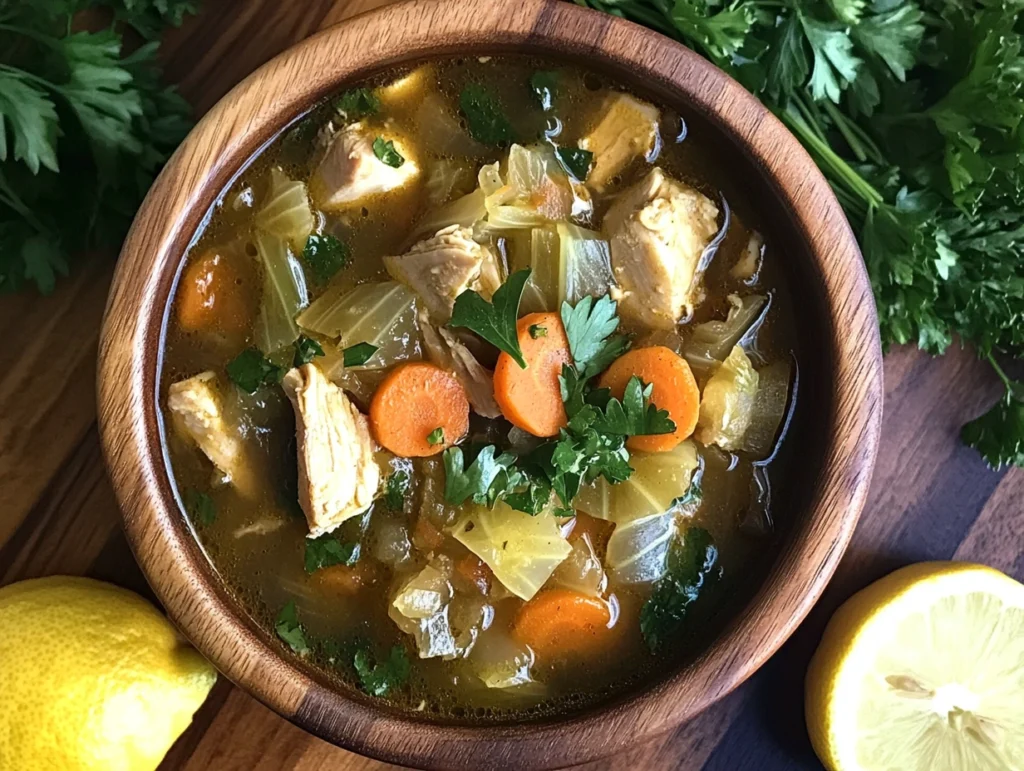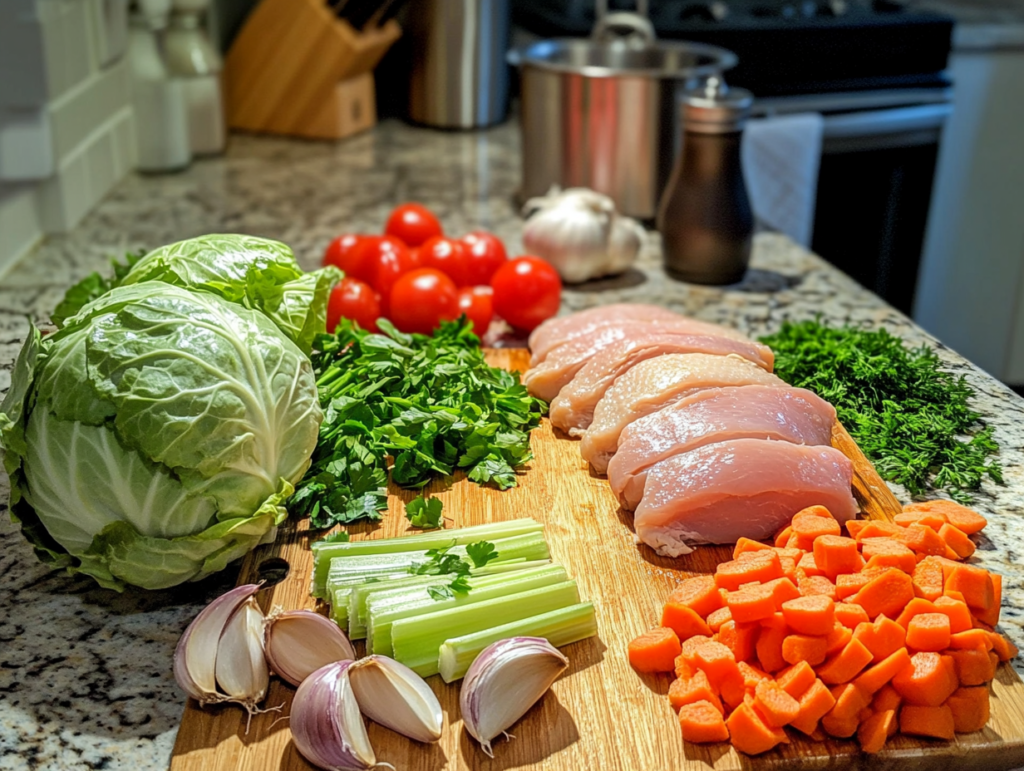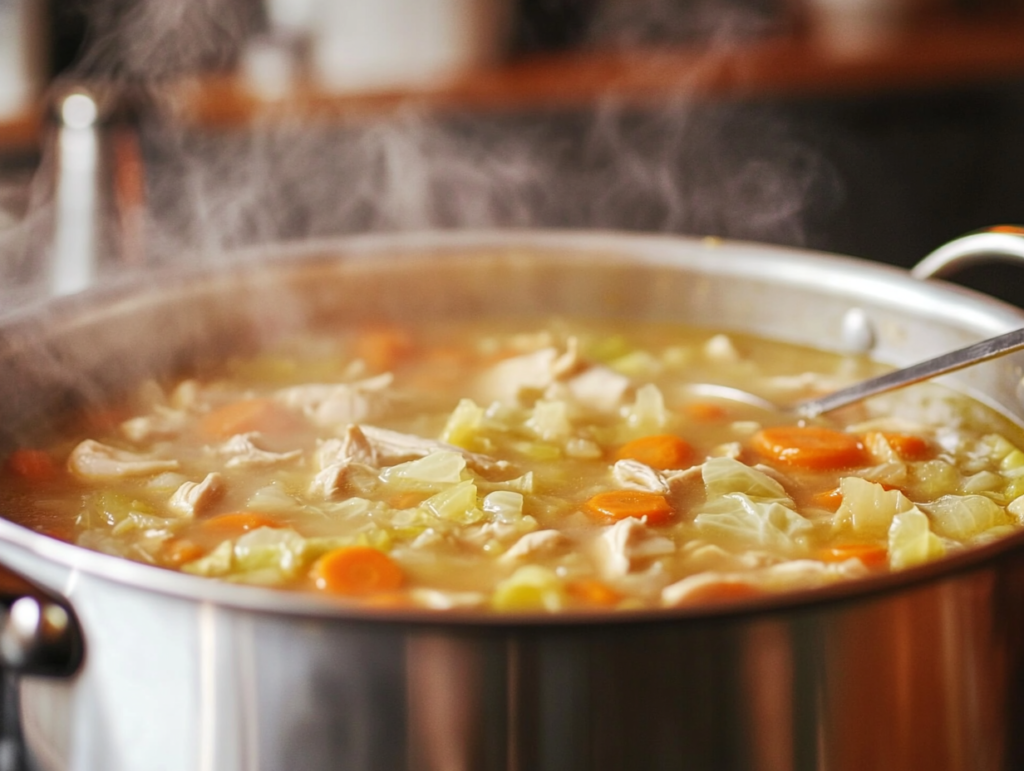1. Introduction
Chicken cabbage soup is a dish that combines simplicity, flavor, and health in a single bowl. This versatile soup is a favorite across households worldwide, cherished for its comforting warmth and its remarkable adaptability to different culinary traditions. Whether you’re looking for a light meal, a cozy winter warmer, or a dish to support your wellness journey, chicken cabbage soup ticks all the boxes.

Alt Text: A steaming bowl of chicken cabbage soup with green cabbage, chicken, carrots, and broth, garnished with parsley and lemon.
Historically, soups have always played a vital role in cultural cuisines, serving as both sustenance and a remedy. Chicken cabbage soup, in particular, has roots in many traditions, often hailed for its ability to nourish and heal. From its association with the cabbage soup diet to its reputation as a low-calorie yet nutrient-rich meal, this humble dish has garnered attention for good reason.
In this guide, we’ll take you through everything you need to know about chicken cabbage soup. From its nutritional benefits to a step-by-step preparation guide, regional variations, and expert tips, this article covers it all. Whether you’re a seasoned cook or a beginner, by the end, you’ll be equipped to make a perfect pot of chicken cabbage soup tailored to your tastes.
2. Nutritional Benefits of Chicken Cabbage Soup
Chicken cabbage soup is not just a comfort food; it’s a powerhouse of nutrition. Combining lean protein, fiber-rich vegetables, and a medley of vitamins and minerals, this soup offers a balanced meal that supports overall health. Let’s break down its key nutritional advantages.
2.1. Health Benefits of Chicken
Chicken is a staple protein in many diets due to its versatility and nutrient density. Here’s why it’s a great addition to your soup:
- High-Quality Protein: Chicken is an excellent source of lean protein, essential for muscle repair, tissue regeneration, and overall growth. One cup of cooked chicken provides about 25 grams of protein.
- Rich in Vitamins and Minerals: Chicken contains important micronutrients such as vitamin B6, which supports brain health, and selenium, a powerful antioxidant that helps combat oxidative stress.
- Low in Calories: Skinless chicken breast, in particular, is low in fat and calories, making it ideal for weight management and heart health.
2.2. Health Benefits of Cabbage
Cabbage, a cruciferous vegetable, is often called a “superfood” for its impressive nutritional profile. When added to soup, it offers:
- Vitamin C: A potent antioxidant, vitamin C boosts immunity and aids in collagen production for healthy skin and joints.
- Vitamin K: Essential for blood clotting and bone health, vitamin K is abundant in cabbage, supporting overall wellness.
- Dietary Fiber: Cabbage is rich in fiber, promoting healthy digestion and a feeling of fullness, which can aid in weight control.
- Antioxidants: Compounds like anthocyanins (in red cabbage) and glucosinolates protect against inflammation and certain diseases.
2.3. Combined Health Advantages
When chicken and cabbage come together, the result is a nutrient-dense, low-calorie meal perfect for various dietary needs. Benefits include:
- Weight Management: This soup is naturally low in calories and high in volume, helping you feel full without overindulging.
- Improved Digestion: The fiber in cabbage works synergistically with the broth to support gut health.
- Boosted Immunity: Vitamins and minerals in both chicken and cabbage strengthen the immune system, making this soup a great choice during cold and flu season.
3. Ingredients Breakdown
Creating a delicious chicken cabbage soup starts with understanding the role of each ingredient. From the star components to the supporting flavors, every element contributes to the overall taste and nutrition.

Alt Text: Ingredients for chicken cabbage soup including cabbage, chicken, carrots, onions, celery, and tomatoes on a kitchen counter.
3.1. Common Ingredients
Here’s a detailed look at the ingredients typically used in chicken cabbage soup:
- Chicken: Opt for skinless chicken breast or thighs for a lean protein source. Bone-in chicken adds depth to the broth.
- Cabbage: Green cabbage is the most common choice, offering a mild flavor and tender texture. Red cabbage adds a touch of sweetness and vibrant color, while Savoy cabbage provides a delicate, crinkled appearance.
- Broth: Chicken broth or stock is the base, providing a rich, savory foundation. Homemade stock elevates the soup, but store-bought works well too.
- Aromatics: Onions, garlic, and celery are essential for building flavor. These vegetables form the base of many soups and bring a subtle sweetness.
- Carrots: Add natural sweetness and a splash of color.
- Tomatoes: Fresh or canned tomatoes contribute acidity, balancing the richness of the chicken.
- Herbs and Spices: Bay leaves, thyme, and parsley are common choices. Salt, black pepper, and optional red pepper flakes adjust seasoning to taste.
- Olive Oil or Butter: Used for sautéing vegetables, enhancing their flavors.
- Optional Additions: Potatoes or rice for added heartiness, or lemon juice for a fresh, tangy finish.
3.2. Selection Criteria for Ingredients
Choosing high-quality ingredients is key to achieving a flavorful soup. Here’s what to look for:
- Chicken: Select fresh, firm chicken with no off smells. Organic or free-range options may offer better flavor.
- Cabbage: Choose heads with tightly packed leaves and a firm, heavy feel. Avoid any with brown or wilted spots.
- Broth: Opt for low-sodium varieties if using store-bought, allowing you to control the salt level.
4. Step-by-Step Preparation Guide
Making chicken cabbage soup is a straightforward process. Follow these steps for a soup that’s bursting with flavor.

Alt Text: A pot of simmering chicken cabbage soup with chunks of chicken, cabbage, and carrots, steam rising above the pot.
4.1. Preparing the Ingredients
- Wash and Chop Vegetables: Rinse cabbage thoroughly to remove any dirt or debris. Chop into bite-sized pieces. Dice onions, mince garlic, and slice carrots and celery.
- Prepare Chicken: If using raw chicken, trim any excess fat. For bone-in cuts, ensure the bones are clean for a clear broth.
4.2. Cooking Process
- Sauté Aromatics: Heat olive oil or butter in a large pot over medium heat. Add onions, garlic, and celery. Cook until softened and fragrant, about 5 minutes.
- Add Chicken and Broth: Place chicken pieces in the pot. Pour in chicken broth to cover, then bring to a boil. Reduce heat to a simmer.
- Incorporate Vegetables: Add chopped cabbage, carrots, and tomatoes. Stir to combine. Simmer for 20–25 minutes, or until chicken is cooked through and vegetables are tender.
4.3. Final Touches
- Adjust Seasoning: Remove the chicken and shred it into bite-sized pieces. Return it to the pot. Taste the soup and add salt, pepper, or red pepper flakes as needed.
- Add Fresh Herbs and Lemon Juice: Stir in chopped parsley and a squeeze of lemon juice for brightness. Discard bay leaves before serving.
5. Variations of Chicken Cabbage Soup
Chicken cabbage soup is a versatile dish, adaptable to various cuisines and dietary preferences. Below are some popular variations to inspire creativity in the kitchen.
5.1. Regional Variations
Asian-Inspired Chicken Cabbage Soup
- Ingredients: Ginger, garlic, sesame oil, soy sauce, and bok choy instead of green cabbage.
- Flavor Profile: Light, aromatic, and slightly salty with umami notes.
- Optional Additions: Mushrooms, rice noodles, or a poached egg for added richness.
- Pro Tip: Garnish with sliced green onions and a drizzle of chili oil for a spicy kick.
European-Style Chicken Cabbage Soup
- Ingredients: Potatoes, leeks, dill, and a touch of cream for a richer base.
- Flavor Profile: Creamy and hearty, with earthy notes from root vegetables.
- Optional Additions: Crumbled bacon or smoked sausage for extra depth.
- Pro Tip: Serve with crusty bread to soak up the flavorful broth.
Mediterranean Twist
- Ingredients: Olive oil, lemon juice, oregano, and olives.
- Flavor Profile: Bright and zesty, with herbal undertones.
- Optional Additions: Feta cheese or chickpeas for a Mediterranean touch.
- Pro Tip: Add a pinch of smoked paprika for subtle warmth.
5.2. Dietary Modifications
Low-Sodium Version
- Replace regular chicken broth with a low-sodium alternative or homemade broth.
- Season with fresh herbs and a squeeze of lemon instead of excessive salt.
Gluten-Free Adaptations
- Avoid any thickening agents like flour or gluten-containing noodles. Use rice or potatoes as substitutes.
Keto-Friendly Soup
- Skip starchy vegetables like potatoes and carrots. Use zucchini or cauliflower instead.
- Incorporate high-fat ingredients like heavy cream or coconut milk for added richness.
6. Common Mistakes and How to Avoid Them
Even simple recipes can go awry without attention to detail. Here are common pitfalls when making chicken cabbage soup and tips to avoid them.
6.1. Overcooking the Cabbage
- Problem: Overcooked cabbage can become mushy and lose its bright flavor.
- Solution: Add cabbage in the final 15–20 minutes of cooking to preserve its texture and nutrients.
6.2. Underseasoning the Broth
- Problem: A bland soup fails to deliver on flavor.
- Solution: Season in layers. Add salt during the sautéing stage, and adjust as needed throughout the cooking process.
6.3. Improper Chicken Preparation
- Problem: Using skin-on or fatty chicken can result in a greasy broth.
- Solution: Opt for skinless chicken or skim the broth with a ladle to remove excess fat.
6.4. Using the Wrong Cabbage
- Problem: Some cabbages may overpower the dish or break down too quickly.
- Solution: Choose cabbages like green, Savoy, or Napa for their balanced flavors and ideal textures.
6.5. Skipping the Acidic Element
- Problem: Without an acidic ingredient, the soup may taste flat.
- Solution: Add a splash of lemon juice or a dash of vinegar to brighten the flavors.
7. Serving Suggestions
Chicken cabbage soup is a versatile dish that pairs beautifully with a variety of sides and garnishes. Here are some ideas to elevate your dining experience.
7.1. Ideal Accompaniments
- Crusty Bread: A warm slice of sourdough or baguette is perfect for dipping into the flavorful broth.
- Rice or Quinoa: Serve the soup over a bed of rice or quinoa for a heartier meal.
- Side Salad: A simple green salad with a light vinaigrette adds a refreshing contrast to the warm soup.
- Pickled Vegetables: Tangy pickled cucumbers or carrots complement the savory notes of the soup.
7.2. Garnishing Ideas
- Fresh Herbs: Sprinkle chopped parsley, dill, or cilantro for a burst of freshness.
- Grated Cheese: Parmesan or a dollop of sour cream adds richness.
- Crunchy Toppings: Toasted nuts, croutons, or fried onions provide texture.
7.3. Serving Tips
- Serve the soup hot in deep bowls to keep it warm longer.
- Pair with a chilled white wine or sparkling water with a lemon slice for a balanced meal.
8. Storage and Reheating Tips
Proper storage ensures that your chicken cabbage soup remains delicious and safe to eat for days or weeks. Here’s how to store and reheat it effectively.
8.1. Refrigeration Guidelines
- How to Store: Allow the soup to cool to room temperature before transferring it to an airtight container.
- Shelf Life: Store in the refrigerator for up to 4 days.
- Pro Tip: Keep the soup in smaller portions for easier reheating.
8.2. Freezing Instructions
- How to Freeze: Pour the soup into freezer-safe containers, leaving some room for expansion. Use a vacuum sealer for longer storage.
- Shelf Life: Frozen soup can last up to 3 months.
- Thawing Tips: Defrost in the refrigerator overnight for best results.
8.3. Reheating Methods
- Stovetop: Heat the soup on medium heat, stirring occasionally to ensure even warming. Add a splash of water or broth if it thickens.
- Microwave: Reheat in microwave-safe bowls in 1-minute increments, stirring between intervals.
- Pro Tip: Avoid overcooking when reheating to preserve the texture of the cabbage and chicken.
9. Frequently Asked Questions (FAQs)
9.1. Why do you lose weight on the cabbage soup diet?
The cabbage soup diet is often linked to rapid weight loss due to its low-calorie nature. The soup is high in fiber, which promotes fullness, and low in fats and carbohydrates, creating a calorie deficit when paired with a controlled diet. However, this diet is usually short-term and primarily results in water weight loss rather than sustained fat reduction.
9.2. Why does my cabbage soup taste so bland?
Blandness in cabbage soup often stems from insufficient seasoning or a lack of flavor-enhancing ingredients. To improve taste:
- Use aromatics like garlic, onions, and celery.
- Add herbs such as thyme, bay leaves, or parsley.
- Incorporate an acidic element like lemon juice or vinegar to brighten the flavors. Remember to season at different stages of cooking and taste-test frequently.
9.3. What type of cabbage is best for soup?
Green cabbage is the most commonly used due to its mild flavor and tender texture when cooked. Savoy cabbage offers a slightly sweeter taste and a delicate, crinkled texture. Napa cabbage is another excellent choice, especially for Asian-inspired variations, as it cooks quickly and absorbs flavors well.
9.4. Why do you put lemon juice in chicken soup?
Lemon juice serves multiple purposes in chicken soup:
- Flavor Enhancement: The acidity balances the richness of the chicken and broth, making the flavors pop.
- Freshness: It adds a bright, fresh element to the dish.
- Preservation: Acidic ingredients can help maintain the soup’s vibrant flavors over time.
10. Conclusion
Chicken cabbage soup is a timeless dish that combines comfort, nutrition, and versatility. From its rich history to its modern variations, this soup continues to be a favorite in kitchens worldwide. Whether you’re preparing it as a hearty meal or a light, health-conscious option, it’s a dish that satisfies on every level.
Through this guide, you’ve learned about the nutritional benefits, essential ingredients, preparation techniques, and ways to customize the soup to your preferences. Additionally, we’ve addressed common mistakes and provided tips for serving, storing, and reheating, ensuring your soup is always flavorful and fresh.
Now it’s your turn to put these tips into action. Experiment with different ingredients, try regional variations, or create your own signature version. Most importantly, enjoy the process and the delicious results!
